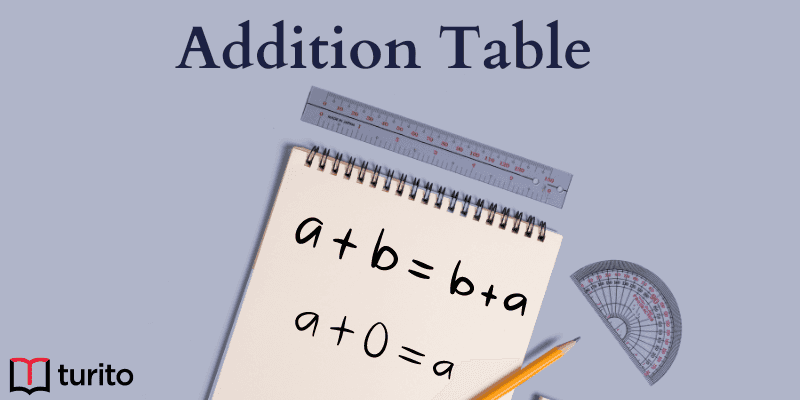Introduction to Addition Table:
Addition Table Chart
The addition table chart for the numbers 1 to 10 can be represented as shown in the figure below.

Pattern:
A number pattern is a pattern or sequence in a series of numbers. This pattern generally establishes a common relationship between all numbers. For example 0, 5, 10, 15, 20, 25, …

Addition Pattern:

Associative property:
20 + 24 = 20 + (2 +22)
= (20 + 2) + 22
20 + 24 = 22 + 22
Commutative property:
20 + 24 = (16 + 4) + (18 + 6)
22 + 22 = (18 + 4) + (16 + 6)
The alternating even and odd numbers in the rows and columns are captured in the following picture:

The reason for the alternating pattern is that each time we move to the box on the right or one below, we add one more to our sum. For example,
(2 + 3) +1 = 2 + (3 + 1) = 2+4

Commutative Property
Add the diagonals to any box.
2 + 4 = 6
3 + 3 = 6
Are the sums of the diagonals always equal?
6 + 8 + 10 = 24
8 + 8 + 8 = 24
6 is 2 less than 8; 10 is 2 more than 8.
Exercise:
- Write addition table for 4.
- Write addition table for 6.
- Complete the addition chart

4. Find the next numbers

5. What numbers are missing?
33, ____, 53, _____, 73, 83, 93, _____
6. Identify the numbers by which the following series of numbers are skipping the counting.
123, 125, 127, 129, 131, 133, 135, 137
7. Use a number line to evaluate each of the following

- (+7) + (+5)
- (+5) + (+3)
- (+3) + (+8)
8. The following problem is an example of which property?
(3+1)+2=3+(1+2)
9 . What number fills in the blank?
i) 5 + ____ = 8 + 5
ii) 8 + 4 = ______ + 8
10. Complete the addition
i) 79 + 1 = ______
ii) 173 + ______ = 174
iii) ______ + 1 = 1460
What We Have Learned:
- Understanding the Addition properties
- Associative property
- Commutative property
- Additive identity
- Addition table
- Pattern in addition to table
- Shapes in addition to table
Concept Map:



Related topics
Addition and Multiplication Using Counters & Bar-Diagrams
Introduction: We can find the solution to the word problem by solving it. Here, in this topic, we can use 3 methods to find the solution. 1. Add using counters 2. Use factors to get the product 3. Write equations to find the unknown. Addition Equation: 8+8+8 =? Multiplication equation: 3×8=? Example 1: Andrew has […]
Read More >>Dilation: Definitions, Characteristics, and Similarities
Understanding Dilation A dilation is a transformation that produces an image that is of the same shape and different sizes. Dilation that creates a larger image is called enlargement. Describing Dilation Dilation of Scale Factor 2 The following figure undergoes a dilation with a scale factor of 2 giving an image A’ (2, 4), B’ […]
Read More >>How to Write and Interpret Numerical Expressions?
Write numerical expressions What is the Meaning of Numerical Expression? A numerical expression is a combination of numbers and integers using basic operations such as addition, subtraction, multiplication, or division. The word PEMDAS stands for: P → Parentheses E → Exponents M → Multiplication D → Division A → Addition S → Subtraction Some examples […]
Read More >>System of Linear Inequalities and Equations
Introduction: Systems of Linear Inequalities: A system of linear inequalities is a set of two or more linear inequalities in the same variables. The following example illustrates this, y < x + 2…………..Inequality 1 y ≥ 2x − 1…………Inequality 2 Solution of a System of Linear Inequalities: A solution of a system of linear inequalities […]
Read More >>Other topics







Comments: